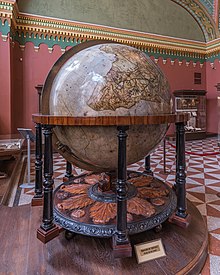Globus Blaeu
The Globus Blaeu ( Russian Глобус Блау / Globus Blau) is a globe made of copper on a wooden frame, which was built in the early 1690s by the heirs of the Amsterdam cartographer Willem Blaeu for the Swedish King Karl XII. was made. This globe has a diameter of 1.71 meters (scale 1: 7.5 million).
After Charles XII. refused to buy the globe that had been specially made for him because he had too high a cost for the Great Northern War , the Russian envoy in Amsterdam took an interest in this rare globe. Because of the high price of such unique pieces, they were only made to order. After an exchange of letters with Peter I in 1708 regarding the possible purchase, the Russian envoy entered into lengthy purchase negotiations with the Blaeu publishing house and negotiated the originally requested price down to a tenth.
The Russian tsar acquired the globe in 1710. It was sent to Russia and placed in the Lefort Palace (now known as the Menshikov Palace ) in Saint Petersburg . A year later, the globe was exhibited to the Moscow public in the Ivan the Great Bell Tower in Moscow . This was the first generally accessible museum in Moscow.
In 1733 the location of the globe was relocated to the Sukharev Tower . There, geographers from the School of Mathematical and Geographic Sciences (Russian Школа математических и навигацких наук ) were trained. The hall that was added to the tower to house the globe, facing Sretenka Street (Russian Улица Сретенка ), was called the Globe Hall .
In 1752 the globe was brought to the Kunstkammer in Saint Petersburg. Obviously, it was supposed to serve as a model for the restoration of the giant Gottorf globe , which was badly damaged in a fire in the Tsarist art chamber when it burned out in 1747.
The sledges for this transport were designed by the architect Dmitri Uchtomski (* 1719; † 1784; Russian Дмитрий Васильевич Ухтомский ).
In the 19th century, the Blaeu globe was exhibited in the Rumyantsev Museum (Russian Румянцевский музей ). At first he was in Saint Petersburg, then in Moscow. In 1912 the administration of the Rumyantsev Museum handed him over to the Moscow State Historical Museum , where it is still located today.
Since Australia had not yet been fully explored when this globe was created, only half of it is shown on the globe.
See also
- Atlas Maior (also from Blaeu)
